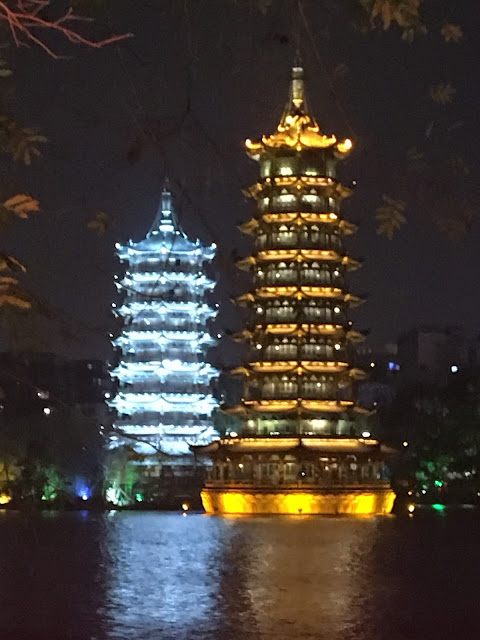What with five weeks in Seattle over the holidays then three weeks in China in February plus a period of decompression (not to mention everyday life) it has been hard to blog lately but I can't help mulling over our trip to China ....
Lily and Luke in China: Since last September, our daughter, Lily, and her boyfriend, Luke Dauner, have been working in Kunming, China at an international school for Chinese students (third grade to high school) who plan to go to college in the United States. Lily and Luke teach them subjects like math, science, and geography in English. The school also has Chinese teachers, so its been a great immersion for them.
The Reason for the Season: Family! The two of them have already done some traveling but only on long weekends. Their first long vacation—6 weeks, from late January through February—was for Chinese New Year, and they invited us to join them on a trip across central and southern China. We overlapped with Luke’s mom, Teri, and his uncle, OJ, on the first part of our trip and with Luke’s dad, Ron, on the last. Chinese New Year is like our Christmas (at least that's what many there told us) with everything decorated and everyone going to see their families, so it was perfect to all be there together!
 |
| OJ, Lily, Brad, Me, Teri, Luke in our apartment in Xi'an |
 |
| Ron, Lily, and Luke in little truck-taxi in Kunming |
Big Picture of Our
Trip. After a 12-hour trip from Rome, we traveled more than 2,000 miles by train and bus, visiting two big cities (Xi’an and Kunming), two beautifully intact ancient
towns (Fenghuang and Li Jiang), and two wild areas (Zhangjiajie and Langshuo/Guilin). This map show our route in its bigger Asian context.
And here's a close-up of the route, followed by some highlights from each stop:
#1: Xi'an
A big, noisy, and largely drab city of over 9 million, Xi'an was the imperial capital for many centuries and is considered the birthplace of Chinese culture. Among many other things, it is home to the famous terra-cotta warriors, a fantastic history museum, an ancient Muslim population (with its own very colorful quarter), and one of the oldest and best-preserved city walls in China.
#2: Zhangjiajie

This is another World Heritage site, consisting of several large parks in the mountains south of Xi'an. We stayed in a local family's guesthouse inside the main park. The views and hikes were amazing. So were the monkeys.
#3: Fenghuang
This stunningly beautiful and extremely well preserved ancient town is another World Heritage site (the UNESCO description at the hyperlink is quite interesting). Its stone buildings date from the late 1500s, but there has been a town here since the 600s, which was an important military post on the frontier between the ruling Han dynasties and the ethnic groups to the south.
Large numbers of Miao or Tujia peoples live in the town, and seeing all the Chinese tourists posing for photos in traditional ethnic garb was one of the highlights of our visit. The gals to the right and left in the photo below (who rented these costumes to the tourists) are presumably the real members of the ethnic groups ...
#4: Guilin/Yangshuo
Guilin is one of China's top tourist attractions because it is so close to the Li River and the surrounding karst landscape, similar to Zhangjiajie's. We arrived after a long bus ride and only stayed the night; but we had enough time to see the Moon and Sun temples and eat in an open air food market (we had Indian food, not scorpions, grubs, or spicy snails).
Afterwards, stayed two nights in nearby Fenghuang, greatly enjoying our little boutique hotel and trips on the Li river.
#5: Kunming
The city where Lily and Luke live and work has almost 8 million people. They live in a gated complex (similar to many in town) of twenty-eight 32-storey apartment buildings. We liked seeing their place, experiencing New Year fireworks, and visiting a temple, park, and lakeside area, each full of celebrating Chinese families.
#6: Lijiang
Yet another historic old town and World Heritage site, Lijiang is famous for its cobblestone streets and canals, and for one of the most photographed scenes in China, Jade Dragon Snow Mountain. We climbed up to an old temple overlooking the town, toured the old streets, and hiked out to a park on the edge of town with the famed mountain scene.
Hope to be adding more details in future posts as we continue to process this amazing trip!
A big, noisy, and largely drab city of over 9 million, Xi'an was the imperial capital for many centuries and is considered the birthplace of Chinese culture. Among many other things, it is home to the famous terra-cotta warriors, a fantastic history museum, an ancient Muslim population (with its own very colorful quarter), and one of the oldest and best-preserved city walls in China.
#2: Zhangjiajie

This is another World Heritage site, consisting of several large parks in the mountains south of Xi'an. We stayed in a local family's guesthouse inside the main park. The views and hikes were amazing. So were the monkeys.
 |
| Home cooking with some local visitors |
#3: Fenghuang
This stunningly beautiful and extremely well preserved ancient town is another World Heritage site (the UNESCO description at the hyperlink is quite interesting). Its stone buildings date from the late 1500s, but there has been a town here since the 600s, which was an important military post on the frontier between the ruling Han dynasties and the ethnic groups to the south.
Large numbers of Miao or Tujia peoples live in the town, and seeing all the Chinese tourists posing for photos in traditional ethnic garb was one of the highlights of our visit. The gals to the right and left in the photo below (who rented these costumes to the tourists) are presumably the real members of the ethnic groups ...
#4: Guilin/Yangshuo
Guilin is one of China's top tourist attractions because it is so close to the Li River and the surrounding karst landscape, similar to Zhangjiajie's. We arrived after a long bus ride and only stayed the night; but we had enough time to see the Moon and Sun temples and eat in an open air food market (we had Indian food, not scorpions, grubs, or spicy snails).
Afterwards, stayed two nights in nearby Fenghuang, greatly enjoying our little boutique hotel and trips on the Li river.
 |
| Welcome for Luke (Lucas) and company |
#5: Kunming
The city where Lily and Luke live and work has almost 8 million people. They live in a gated complex (similar to many in town) of twenty-eight 32-storey apartment buildings. We liked seeing their place, experiencing New Year fireworks, and visiting a temple, park, and lakeside area, each full of celebrating Chinese families.
 |
| Lily's Christmas tree of tinsel on the wall plus New Year's lanterns |
#6: Lijiang
Yet another historic old town and World Heritage site, Lijiang is famous for its cobblestone streets and canals, and for one of the most photographed scenes in China, Jade Dragon Snow Mountain. We climbed up to an old temple overlooking the town, toured the old streets, and hiked out to a park on the edge of town with the famed mountain scene.
Hope to be adding more details in future posts as we continue to process this amazing trip!











































